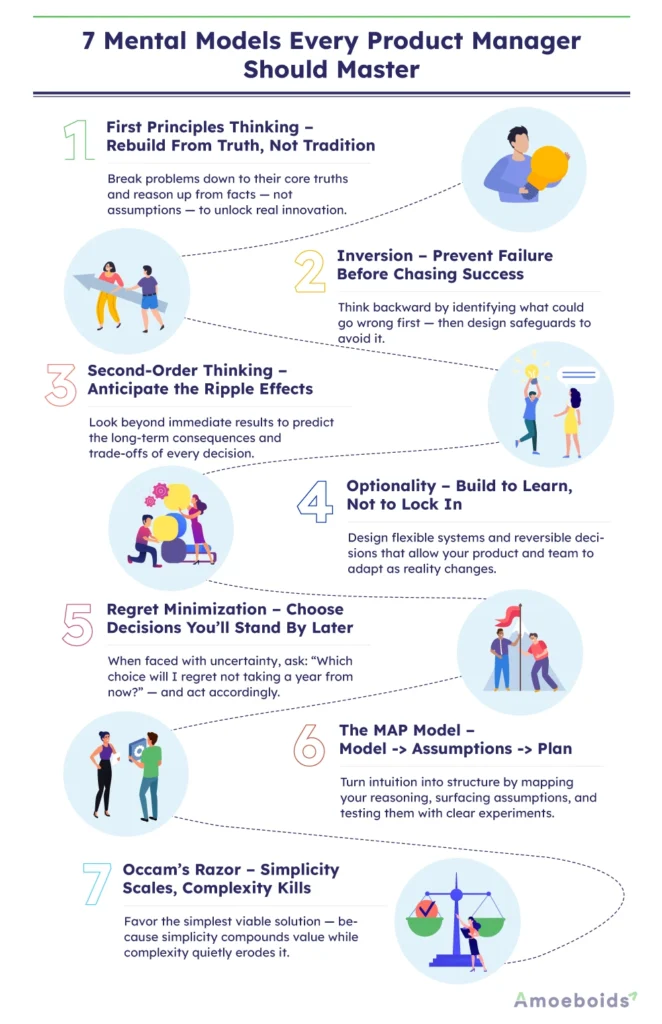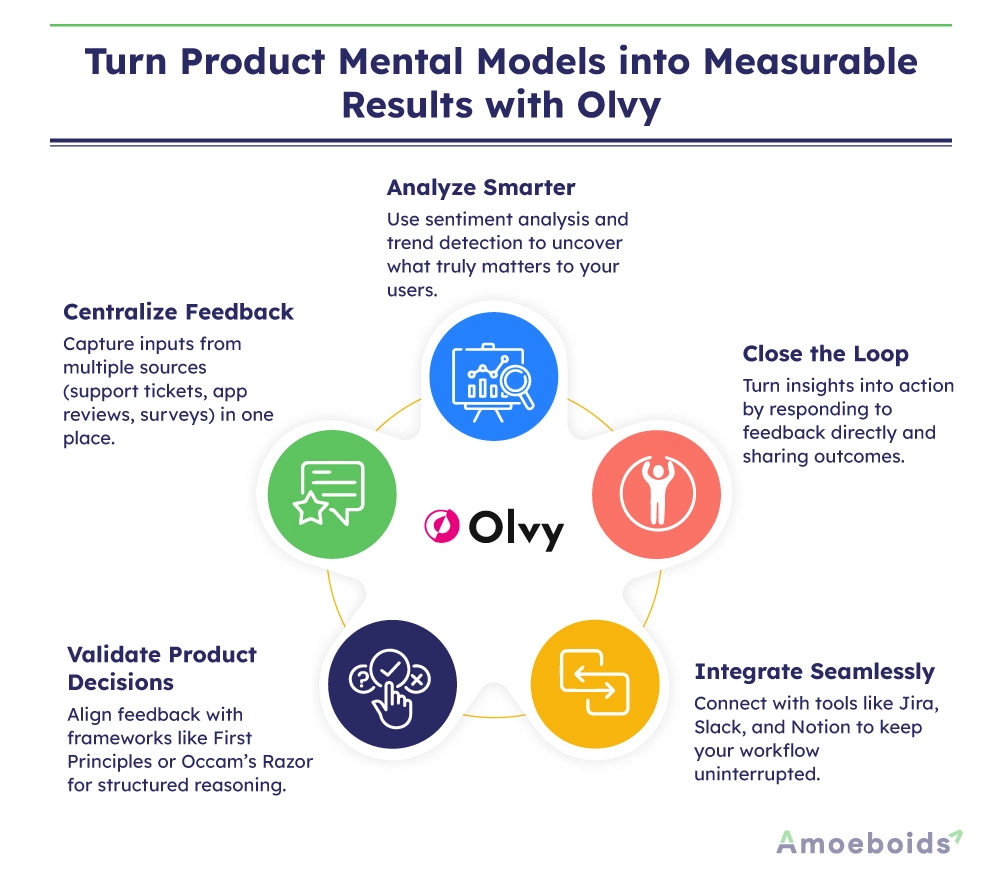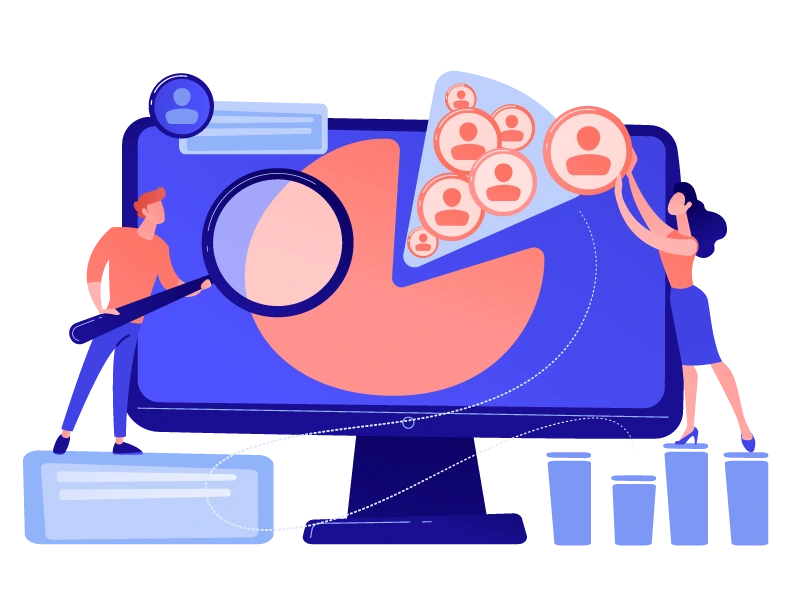In product management, speed often gets celebrated more than the good outcomes. But the best product managers know that good outcomes start with good thinking.
Every roadmap, every feature, every pricing tweak is ultimately a decision problem – one that benefits from structure.
That’s where mental models for product managers come in.
These are not buzzwords; they’re cognitive frameworks for product managers that help analyze problems, anticipate trade-offs, and make choices with clarity. Whether you call them product thinking frameworks, decision-making models in product management, or simply concepts for product managers, they’re the backbone of strategic reasoning for Product Managers in the modern SaaS world.
In this guide, we’ll walk through seven powerful mental models that explain how product managers can make better decisions, supported by SaaS-specific examples and tips on how to apply each one.
Why Mental Models Matter in Product Management
At every lifecycle stage of the product, Product teams are bombarded with feedback.
In the early stage it is the feedback from their business stakeholders to get the product off the ground, combined with the feedback from early customers.
Once your product starts making waves in the market you start receiving the feedback from Marketing & Sales teams. Support teams also contribute to this feedback heap.
And of course, once there are a number of customers using your product – there’s no stopping them. They will have their own ideas around what the product should do for them & how.
Eventually as a product manager, your every day is filled with choices:
- What problem deserves attention first?
- Should you build or integrate?
- Which feedback signals represent reality?
Look closely & you will realise that these aren’t execution challenges; they’re thinking challenges.
Mental models give Product Managers reusable ways to reason through complexity – frameworks for better product decisions that transform gut feel into structured analysis. They’re the difference between reacting to the Product management metrics and understanding what drives them.
When you learn how to apply mental models in product management, you gain a shared language for your team’s judgment – a set of thinking tools every product manager should have.
Let’s explore seven of them that consistently show up in the decision frameworks used by successful product managers.

1. First Principles Thinking – Rebuild From Truth, Not Tradition
Every product manager has heard it: ‘That’s how it’s always done’. But that’s often the moment innovation quietly dies.
First Principles Thinking helps you break that cycle. It’s the discipline of dissecting a problem into its most basic truths – stripping away assumptions, conventions, and ‘best practices’ – then reasoning upward from facts. It’s one of the most essential decision-making models in product management because it teaches you to think independently, not comparatively.
How to apply the First Principles Thinking mental model in product management
Most Product Managers begin with ‘How do we improve X?’
Those thinking from first principles begin with ‘Why does X exist in the first place?’ and ‘What must be true for this to matter?’
Here’s a simple 3×3 Product Lens to help you get started:
- Users – What fundamental behavior are we assuming?
- Do users really want this feature, or are we projecting our own habits?
- Are we solving a problem they say they have or one they actually feel?
- Business – What constraint are we treating as fixed?
- Are we assuming pricing, positioning, or go-to-market strategy limits that no longer exist?
- What if we rebuilt this process for a single goal – profit, retention, or speed – how would it look?
- Technology – What do we believe is ‘hard’ that may no longer be?
- Are we ignoring possibilities unlocked by AI, APIs, or automation?
- What if we started from today’s capabilities, not last year’s tech stack?
When you challenge assumptions across these three lenses, old answers start to feel outdated – and new patterns emerge.
SaaS example
A B2B analytics platform sees low dashboard adoption. The team’s reflex is to improve chart variety. Applying first principles, they step back: What’s the real job-to-be-done? It isn’t ‘create pretty graphs,’ it’s ‘communicate performance to leadership.’ The team simplifies the product around automated summary reports instead – usage soars.
Why it matters
This approach is the foundation of critical thinking for product managers and the heart of product thinking frameworks. It separates iteration from innovation and turns product managers from feature operators into strategic thinkers.
2. Inversion – Prevent Failure Before Chasing Success
If First Principles Thinking asks ‘What’s true?’, Inversion asks ‘What could go wrong?’
It’s one of the simplest yet most powerful product management decision frameworks because it forces you to confront reality before optimism takes over. Product managers love to talk about growth, engagement, and delight – but the best ones quietly design against disaster.
Inversion helps you identify the conditions that guarantee failure, so you can remove them before they compound. It’s the habit of thinking backward to move forward – a critical skill in strategic thinking in product management.
How to apply the Inversion mental model in product management
Use the 4F Playbook whenever you’re planning a release or major change:
- Find the failure – Ask: What would make this initiative flop completely?
- Would users misunderstand the value?
- Could onboarding friction or data migration pain stop adoption cold?
- Frame the causes – For each failure, list root causes: unclear UX, poor defaults, misaligned pricing, internal dependencies.
- Fix what’s fragile – Design pre-emptive solutions: simplify flows, strengthen QA, write crisper copy, or stage rollout by cohorts.
- Facilitate a pre-mortem – Before launch, run a 30-minute ‘Assume it failed’ session. Ask everyone – design, engineering, support – to name one reason it could bomb. Collect, cluster, and mitigate.
SaaS example
A team preparing to migrate customers to a new billing system anticipates success metrics around revenue recognition. Using Inversion, they instead ask, ‘What could cause chaos on day one?’ Their list includes incorrect tax handling, confusing email templates, and API version mismatches. Fixing these early prevents escalation and support overload post-launch.
Why it matters
Inversion turns risk management into a framework for better product decisions. It shifts the Product Manager’s mindset from firefighting to foresight – embedding reliability into your product culture.
Fact: preventing failure is often the fastest path to long-term success.
3. Second-Order Thinking – Anticipate the ripple effects
Whether you notice it or not, every product decision creates a ripple.
- You increase engagement, but support tickets spike.
- You simplify onboarding, but conversion quality drops.
- You celebrate a short-term win that quietly erodes long-term trust.
Second-Order Thinking trains product managers to see beyond the immediate outcome – to ask, ‘What happens after this works?’
It’s one of the most valuable product management frameworks for better decision making because it turns quick metrics into thoughtful product strategy. Where first-order thinking focuses on results, second-order thinking focuses on consequences.
How to apply the Second-Order Thinking mental model in product management
Use the Ripple Map Method to stress-test big decisions:
- Define the first-order goal
Be explicit about what success looks like right now – more engagement, higher revenue, faster activation.
- Map the ripples – Ask: If we achieve this, what new behaviors will it trigger?
- Will increased notifications cause alert fatigue?
- Will a freemium plan cannibalize enterprise deals?
- Will added flexibility make onboarding harder?
- Measure the trade-offs
Quantify likely side effects: churn risk, support cost, infrastructure load, data complexity. Use ‘If X then Y’ statements to make them visible to the team.
- Build guardrails
Design features with boundaries – caps, opt-outs, education, or progressive rollouts with feature flags. Guardrails keep success from turning into self-inflicted failure.
SaaS example
A SaaS analytics company introduces real-time dashboards to boost perceived value. First-order effect: customers love it. Second-order effect: cloud costs triple and dashboards slow down during peak hours, hurting reliability. A Product Manager practicing second-order thinking would have modeled this ripple early, implemented sampling, and phased the rollout to maintain performance and trust.
Why it matters
Second-order thinking builds systems awareness – the foundation of a mature product manager mindset. It helps Product Managers connect short-term experiments with long-term sustainability, aligning product health with business health.
In short, it’s how product managers make better decisions that scale.
4. Optionality – Build to learn, not to lock in
Markets move faster than most roadmaps.
Customer needs evolve, new integrations emerge, and technology reshapes what’s possible every quarter.
In this environment, the best product managers don’t plan for certainty – they design for change.
Optionality is the practice of keeping future paths open without stalling execution. It’s a crucial principle inside many product thinking frameworks because it treats learning as an asset and reversibility as a design goal.
Instead of locking the team into rigid architectures or one-way bets, optionality gives you permission to adapt as reality unfolds. It’s not indecision – it’s structured flexibility.
How to apply the Optionality mental model in product management
Use the 4D Framework to balance focus with flexibility:
- Distinguish irreversible decisions from reversible ones
- An irreversible decision (like migrating your database or pricing model) deserves rigorous validation.
- A reversible decision (like button copy or minor UX flow) can be tested quickly.
This distinction prevents over-analysis where speed matters and under-analysis where risk hides.
- Design experiments, not endpoints
- Launch MVPs, alpha features, or betas that validate assumptions before scaling.
- Use feature flag tools for limited-access rollouts to capture early data while protecting stability.
- Develop for extensibility
- Architect with modular APIs, clear data boundaries, and integration hooks.
- Think of every component as something that may evolve or connect differently later.
- Document learning velocity
- Don’t just count features shipped – track insights gained per experiment.
- Learning velocity determines whether your team is compounding or just moving.
SaaS example
A B2B workflow automation startup wants to embed AI suggestions into its rules engine. Instead of rebuilding everything, the Product Manager releases a simple ‘AI Assist’ sidebar to a subset of accounts. The experiment yields two insights: which use cases resonate with customers, and where the current data model limits future expansion. That learning guides the product roadmap far better than assumptions ever could.
Why it matters
Optionality is one of the most overlooked decision frameworks used by successful product managers. It turns uncertainty into optional profit instead of potential loss.
By designing reversible decisions and adaptive systems, you future-proof your product and empower your team to explore without fear – a hallmark of strategic thinking in product management.
Optionality is not hesitation. It’s confidence expressed as flexibility.
5. Regret Minimization – Choose decisions you’ll stand by later
Every product manager faces crossroads where the data is inconclusive, timelines are tight, and the stakes feel uncomfortably high. You could play it safe and wait for more evidence. Or you could take a calculated bet and learn faster.
The Regret Minimization Framework helps you decide which path to choose. It’s a decision-making model in product management built around one simple but powerful question:
A year from now, which decision will I regret not taking?
It’s not about being bold for the sake of it – it’s about aligning choices with long-term learning, not short-term comfort.
How to apply the Regret Minimization mental model in product management
Think of it as a 4R Framework for product decisions under uncertainty:
- Rewind
Step forward in your mind – six months, twelve months, two releases later. Imagine you’re looking back on today’s decision.
- Reflect
Ask: What would I wish I had done when I had the chance? Often, the answer reveals whether fear or logic is driving hesitation.
- Rate reversibility
Not all risks are equal. Identify whether the decision is reversible (feature experiment, pricing test) or irreversible (infrastructure migration, brand change). Move fast on the former; validate deeply on the latter.
- Record and rally
Once you decide, document the reasoning and share it with stakeholders. It builds confidence and makes learning visible, even if the outcome differs from the intent.
SaaS example
A B2B SaaS team debates introducing a usage-based pricing tier. The market trend points in that direction, but internal data is inconclusive. Applying regret minimization, the PM asks: If competitors adopt this and we don’t even test it, will we regret the missed insight?
They launch a pilot for 10% of accounts, learning which usage signals predict upgrade readiness. Even if it’s not a hit, they’ve gained strategic knowledge competitors would pay for.
Why it matters
Regret minimization blends courage with reasoning – a hallmark of strategic thinking in product management.
It keeps teams from paralysis by analysis and anchors them to what matters most: compounding learning over time. In practice, it’s one of the most reliable frameworks for better product decisions, because it honors two truths: not every bet must pay off, but every bet should teach you something.
6. The MAP Model: Model → Assumptions → Plan
When product decisions feel scattered, it’s rarely due to lack of ideas. It’s usually because the team never aligned on the why behind the what.
The MAP Model brings that clarity.
It’s a simple but powerful way to visualize your reasoning – one of the most underrated product management decision frameworks for improving judgment, prioritization, and alignment.
MAP stands for Model → Assumptions → Plan.
It forces teams to slow down just long enough to think clearly before executing fast.
How to apply the MAP Model in product management
Think of it as your team’s pre-flight checklist:
- Model – Define your worldview
Write down how you believe the system works.
- “Users are churning because onboarding takes too long.”
- “Trial users convert poorly because pricing is hidden.”
A clear model expresses your current understanding – not truth, but a working hypothesis.
- Assumptions – Surface what must be true
List every belief that underpins that model.
- “Users value speed more than guidance.”
- “They understand our pricing page when they see it.”
This step is where most Product Managers discover gaps, beliefs stated as facts.
- Plan – Design how you’ll test or validate it
Define one action or experiment that can prove or disprove those assumptions.
- “Run two onboarding variants: guided vs. streamlined.”
- “A/B test transparent pricing vs. gated demo.”
The output isn’t a roadmap item – it’s clarity about whether your mental model is sound.
SaaS example
A B2B analytics platform struggles with low report usage.
- Model: Users avoid reports because they’re too complex.
- Assumptions: Simpler UI will drive engagement.
- Plan: Redesign report builder with one-click templates.
After launch, metrics barely move. The team re-runs the MAP exercise and discovers the deeper truth: users don’t understand why the reports matter. They add contextual ‘insight prompts’, which lift engagement by 40%.
Why it matters
MAP converts intuition into structure – a hallmark of cognitive frameworks for product managers. It exposes assumptions before they cost sprints, and it turns team debates into testable hypotheses.
Used consistently, MAP becomes a lightweight product management framework for better decision making – replacing opinion-driven planning with evidence-driven progress.
The best Product Managers don’t just act fast. They think visibly – and MAP is how they make that visible thinking a habit.
7. Occam’s Razor – Simplicity scales, complexity kills
As products mature, complexity creeps in silently. Each release adds ‘just one more option’. Each customer feedback adds ‘just one more toggle’.
Before long, your once-elegant product feels like an airplane cockpit.
That’s why smart Product Managers rely on Occam’s Razor – the principle that when faced with multiple solutions, the simplest viable one is usually the best.
In product management, Occam’s Razor isn’t about cutting corners; it’s about cutting clutter. It’s one of the most timeless mental models for product design and strategy – reminding teams that simplicity compounds, and complexity decays.
How to apply the Occam’s Razor mental model in product management
Try the SCORE Framework when facing competing design or roadmap choices:
- Simplify the Job
Return to the user’s core job-to-be-done.
Ask: What’s the most direct path to solving this without distractions?
This clarity usually eliminates half the ideas on the table.
- Compare for Clarity vs. Completeness
List your solution options and rate each on a 2×2 axis – Simplicity (ease of use) vs. Completeness (covers edge cases).
Favor solutions that deliver 80% of the value with 20% of the complexity.
- Optimize the Flow
Audit user steps and eliminate redundant clicks, unclear settings, or hidden configuration.
Default intelligently. Automate what users shouldn’t have to think about.
- Review for Explainability
A simple test: Can a new user explain the feature back to you in one sentence?
If not, you’ve added complexity faster than value.
SaaS example
A B2B reporting SaaS tool kept adding new filters and visualization types to ‘increase flexibility’. Activation plummeted. Applying Occam’s Razor, the Product Manager re-centered on the core job: ‘Help managers understand what’s working’.
They redesigned the UI around default dashboards for 80% of users and moved advanced options to an expert mode.
Onboarding time dropped by half, and user satisfaction shot up.
Why it matters
Simplicity isn’t a design preference, it’s a growth strategy. Every added feature carries long-term costs: more onboarding friction, more support queries, more maintenance. Occam’s Razor guards against that entropy.
It’s a key principle of strategic thinking in product management, helping Product Managers make confident trade-offs and preserve usability as scale increases.
In the long run, simplicity becomes your brand’s competitive moat – because customers rarely switch from simple and clear to complex and confusing.
Embedding mental models into your product culture
Mid-level Product Managers aiming for senior roles must not only think clearly themselves but teach structured thinking.
Here’s how to embed these product management frameworks for better decision making across teams:
- Add a ‘key assumptions’ box in every PRD (MAP).
- Run ‘failure pre-mortems’ before launches (Inversion).
- Use ‘second-order retrospectives’ to discuss side effects, not just results.
- Design architecture for extension, not perfection (Optionality).
- Reward simplification in demos (Occam’s Razor).
Embedding these thinking tools every product manager should know transforms decision quality across engineering, design, and business.
From better thinking to better outcomes
All great product outcomes start with clear thinking. Mental models bring that clarity by transforming decisions from instinct to structured reasoning.
But frameworks alone aren’t enough – they need accurate feedback loops.

That’s where Olvy helps.
Olvy enables Product Managers to collect, analyze, and act on product feedback, turning raw data into the kind of insight these models thrive on. With it, you can:
- Validate assumptions early (MAP + First Principles).
- Detect second-order effects through sentiment trends.
- Avoid feature bloat guided by Occam’s Razor.
- Make decisions grounded in evidence, not hunches.
It’s the bridge between your mental models for product managers and the real users you’re building for.
Final thoughts
The future of product management belongs to those who can think clearly amid ambiguity.
Whether you call them product thinking frameworks, decision-making models in product management, or simply ways to think better, these tools will sharpen your reasoning and elevate your team’s judgment.
So next time you face a roadmap debate or a strategic dilemma, don’t just ask what should we do next?
Ask which mental model applies here? Because great products aren’t accidents.
They’re outcomes of clear, structured, deliberate thought – the kind that mental models make possible.



